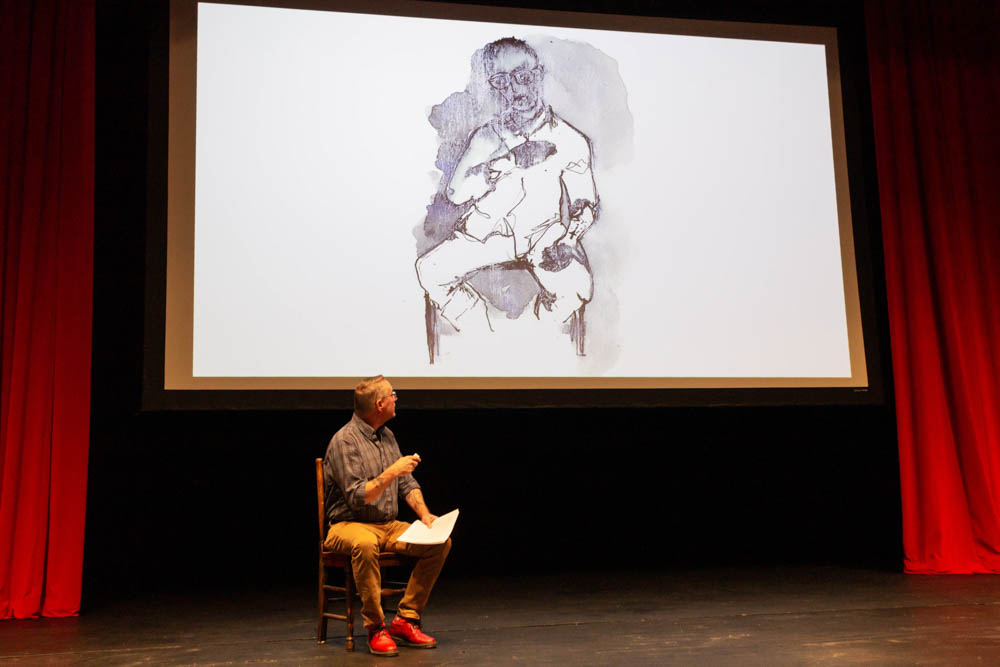
Grace Montgomery
Contributing Writer
Last week on Facebook, I noticed there was an upcoming performance called “The Anxiety Project” presented by Dr. William Doan of Penn State University. I clicked on the link to the event and was intrigued by the description: “A thought-provoking live performance that explores what it is like to live with anxiety and depression.”
A live performance of anxiety and depression? Anxiety and depression are hard concepts to even explain to yourself. I was nervous, to say the least, of how the two disorders that I have had for a decade would be depicted: would something set me off? Would I get angry, sad, scared, hopeless? Would Doan be genuine in his approach or treat it as a theatrical performance?
At the start of the performance, Doan laid out the basis for his work. On the projector screen behind him on stage was a watercolor and ink-based picture of himself hunched within a cracked rib cage. In creating all of the drawings, he noted that he had undergone a “deep and sustained look through my past,” which has allowed him to “confess a deep truth that was at once humiliating.”
Doan started The Anxiety Project to confront his fears that he might one day “unravel,” particularly after the death of his sister from a traumatic brain injury. Doan has been living with anxiety and depression all of his life, but is using his art as a way to “image [his] mental health rather than [his] mental illness.”
By using elements of science, such as technical drawings of the automatic nervous system, as well as statistics — for example, 40 million American adults suffer from anxiety, and about half that number also suffer from depression — Doan was able to depict the complex and interdisciplinary natures of the two illnesses.
Overall, Doan’s art and his story were a mix of his emotional, physical and psychological highs and lows. He would make us laugh with him about his anxiety when getting his first Communion, or his innate confusion at the seemingly endless aisles of toilet paper in Walmart.
After the laughs, a crisp silence would follow. He showed on the screen a picture of a coffin as he mentioned his friend from his Communion story suddenly passing away, or his toxic relationship with his father. In those moments, where I was listening to the theater full of the sound of unfiltered happiness and then the subsequent nothingness my own thoughts; that is when I knew Doan had connected with me.
Doan did not try to use laughter and sorrow to pull his audience in as a means to enhance his performance. Anxiety and depression are a never-ending roller coaster. Happiness and dread can be interwoven and difficult to untangle even in the best moments. Sometimes the nervousness, self-loathing and hopelessness can be channeled into laughter, inspiration, creativity and pride. Other times, my anxiety can lead me to isolate myself and devoid myself of the happiness that I think I deserve. At points, his voice would crack, demonstrating his vulnerability, conviction and his rawness in telling us about his battles and his memories.
Following the performance, Carina Arnosti ’21 noted that “It was emotionally powerful. I was able to relate to Doan’s experience in multiple ways and his vulnerability was inspiring.” Matt Prill ’23 also enjoyed the performance and how it fostered a conversation about topics that can get easily slipped under the rug. “I really loved the performance,” said Prill. “I thought his art was breathtaking and really captured what life with a mental illness is like. Discussions like these are essential in today’s world. Anxiety and depression, as well as other mental illnesses, affect so many people, yet no one talks about it.”
Doan ended his performance with a discussion that there are resources available at Wooster, including considerate faculty and staff, as well as services at the Wellness Center. If anyone needs help, always know that you can ask for it. While we may not all have the courage to get on a stage to discuss our struggles, it is these discussions that are helpful and essential in reminding us that we are never truly alone.
